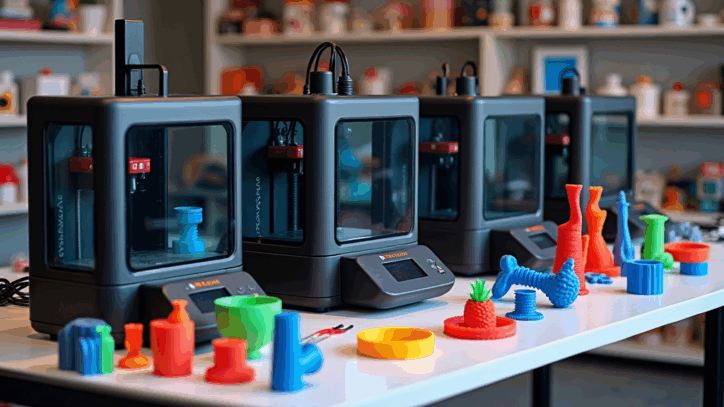
(Disclaimer: This post contains affiliate links. If you make a purchase through these links, we may earn a small commission at no extra cost to you. This helps support the site. You can find our full affiliate disclosure here.)
If you’ve been in the 3D printing world for more than a couple of years, you know the routine. You remember spending 20 minutes with a piece of paper, meticulously leveling each corner of the print bed. You remember “dialing in” your settings, tuning extruder steps, and nervously watching the first layer, praying it would stick.
That era is over.
In the last 12 to 18 months, the desktop 3D printer market has undergone its most significant transformation to date. The “tinkerer’s hobby”—a pastime that was as much about machine calibration as it was about creation—has given way to a new generation of high-speed, automated, “appliance-like” machines.
These new printers are less like project cars and more like microwaves: You put something in, press a button, and trust that you’ll get the expected result.
Let’s break down this massive shift, what’s driving it, and what it means for everyone from first-time buyers to seasoned professionals.
The “Before” Picture: A Hobbyist’s Labor of Love
Until recently, buying a desktop 3D printer, especially a budget-friendly one, was an invitation to tinker. The unspoken agreement was that you’d get a functional “kit,” but it was your job to make it print well.
This meant:
- Manual Leveling: The single most common point of failure.
- Slow Speeds: A standard, “good” quality print chugged along at 50-80 mm/s. A 10-hour print was common.
- Constant Calibration: You had to manually adjust settings to compensate for mechanical quirks.
- Single-Color: Printing in one color was the default. Multi-color was a complex, finicky, and expensive modification.
It was a hobby about 3D printing, not just using a 3D printer. This high barrier to entry kept many potential creators on the sidelines.
The Tipping Point: The “Bambu Lab Effect”
It’s impossible to discuss this transformation without mentioning the catalyst. When Bambu Lab, a newcomer to the scene, launched its X1-Carbon, it didn’t just release a new printer; it released an entirely new standard.
For the first time, one consumer-grade machine offered:
- Extreme speed (CoreXY motion system)
- Fully automatic bed leveling (using Lidar)
- AI-powered failure detection
- An integrated, user-friendly multi-color system (the AMS)
This “it just works” philosophy, priced aggressively, sent a shockwave through the industry. Established brands like Creality, Prusa, Anycubic, and Elegoo were forced to innovate at a breakneck pace to compete. The result? A “race to the top” that has benefited consumers immensely.
The New Standard: Speed is No Longer a Luxury
The most obvious change is the speed. That old 60 mm/s standard is gone. New printers now boast top speeds of 500 mm/s or more, with high-quality “normal” speeds well over 200-300 mm/s. A print that once took 10 hours can now be completed in two.
This is made possible by two key technologies becoming standard:
- CoreXY Kinematics: This is a motion system where the print head is controlled by two stationary motors. By reducing the weight of the moving parts, the printer can achieve incredible speeds and acceleration without shaking itself apart.
- Input Shaping (Resonance Compensation): This is the “magic” software feature. An accelerometer in the print head “listens” to the machine’s vibrations at high speeds and generates a software filter to cancel them out. This completely eliminates the “ringing” or “ghosting” artifacts that used to plague fast prints, resulting in clean, sharp corners even at high velocity.
This combination is now the benchmark for performance on flagship machines from Bambu, Prusa, and Creality’s K-Series.

The Multi-Color (and Multi-Material) Revolution
For years, printing with multiple colors was a nightmare. It required complex add-ons, filament splicing, or unwieldy manual swap commands. Now, it’s becoming a simple, plug-and-play feature.
There are two main approaches emerging:
1. Automatic Material Systems (AMS)
Popularized by Bambu Lab’s AMS and now being adopted by others (like Creality’s CFS), this is a “smart” dry box that holds 4 (or more) spools. The printer automatically feeds, retracts, and purges the old color to load the new one, all in the middle of a print. This is the most popular solution for hobbyists wanting to print detailed, colorful models.
2. Independent Tool Changers
This is the professional-grade solution, most notably seen on the Prusa XL. Instead of one nozzle swapping filaments (which creates a wasteful “purge” tower), the printer has multiple, independent print heads. When it’s time to change, it simply parks one tool head and picks up another.
The benefits are enormous:
- Zero Waste: No purge blocks or towers.
- True Multi-Material: You can print with wildly different materials in one part, like a rigid PLA body with flexible TPU grips or a part with dissolvable supports for complex, impossible-to-print geometries.
“It Just Works”: The Rise of the Automated Appliance
The most profound shift is in reliability. The new goal for manufacturers is to eliminate human error and guesswork from the printing process.
- Fully Automatic Bed Leveling: You will never use a piece of paper again. Modern printers use force sensors, Lidar, or strain gauges in the nozzle to probe the bed and create a perfect first layer every single time, with zero user input.
- AI Failure Detection: This is the game-changer for reliability. An onboard camera watches the print. If it detects a “spaghetti” monster, a detached part, or a first-layer failure, it automatically pauses the print and sends an alert to your phone. This saves countless hours of cleaning and tons of wasted filament.
- Enclosed & Filtered Chambers: More printers now come fully enclosed. This isn’t just for looks; it maintains a stable, high-temperature environment inside, which is essential for printing engineering-grade materials like ABS, ASA, and Carbon Fiber without warping. Many also include activated carbon air filters, making them safer to use in a home office.
What This Transformation Means for You
This new era of 3D printing is fantastic news for everyone.
- For Beginners: The barrier to entry has never been lower. You can now buy a printer, unbox it, and have a perfect, high-speed, multi-color print in your hands the very same day.
- For Hobbyists: You can finally spend less time tinkering with your printer and more time creating with it. Your focus shifts from “Will this print?” to “What should I make next?”
- For Professionals: Desktop printers are no longer just prototyping toys. They are now reliable, fast, and versatile tools capable of small-scale production, creating custom jigs, or manufacturing end-use functional parts from advanced materials.
The 3D printer has finally grown up. It’s no longer just a project; it’s a powerful tool.
(Ready to make the jump? Check out the latest deals at the Creality Store.)

